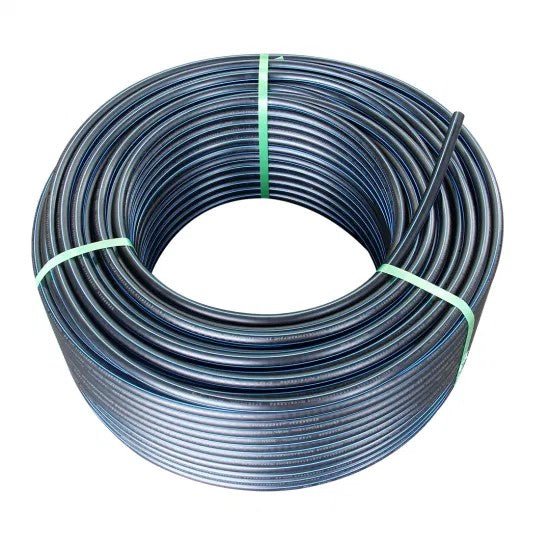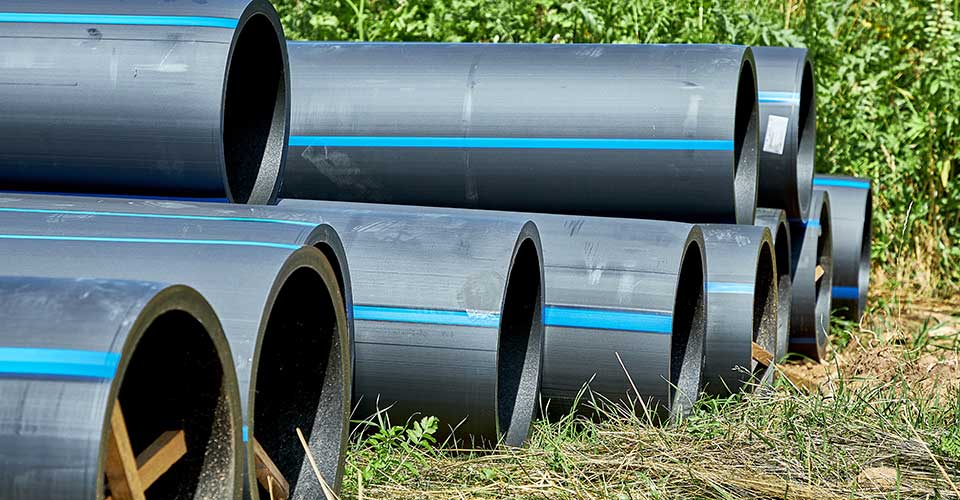hdpe pipe suppliers Midland TX: Checklist for Contractors
Wiki Article
Explore the Production Refine Behind High-Quality HDPE Pipeline and Its Applications
The manufacturing procedure of high-grade HDPE pipelines is complex and methodical. It begins with the choice of resources that improve efficiency. Following this, ethylene undertakes polymerization to create resin, which is after that shaped with extrusion. Quality assurance is critical, ensuring that the final item fulfills rigid requirements. The trip of HDPE pipes does not end with production. Their applications throughout numerous sectors reveal a wider value worth checking out.Understanding HDPE: Properties and Advantages

High-density polyethylene (HDPE) is a functional polycarbonate understood for its sturdiness and resistance to various environmental elements. This product exhibits superb tensile stamina, making it ideal for demanding applications. Its low-density structure contributes to a lightweight product, helping with ease of dealing with and installation. HDPE likewise showcases amazing resistance to chemicals, which lessens destruction when subjected to rough substances.
The product's low dampness absorption better improves its longevity, making it suitable for usage in pipes and tank. Furthermore, HDPE is resistant to ultraviolet (UV) radiation, guaranteeing that items maintain their honesty even when revealed to sunlight. Its versatility enables for the production of complex shapes without endangering strength. The eco-friendly nature of HDPE, often originated from recycled materials, contributes to its charm, advertising lasting methods in production. Overall, these properties and benefits make HDPE a preferred choice for different commercial and consumer applications.
Resources Selection for HDPE Manufacturing
The option of basic materials for HDPE production is vital to validate the end product fulfills the preferred requirements and high quality standards. High-density polyethylene (HDPE) is largely generated from polymerized ethylene, originated from fossil gas such as gas or unrefined oil. The high quality of these feedstocks considerably affects the mechanical and thermal residential properties of the last HDPE.Ingredients additionally play a substantial function in improving HDPE's performance, consisting of antioxidants, UV stabilizers, and colorants, which enhance sturdiness and resistance to environmental variables. The option procedure must take into consideration not only the chemical composition of the raw products however additionally their handling features to assure efficient production.
The sourcing of raw products ought to prioritize sustainability and compliance with environmental guidelines, as responsible methods are vital in today's market. Inevitably, mindful raw material option lays the structure for producing top notch HDPE pipes appropriate for varied applications.
The Extrusion Process: Shaping HDPE Pipe
The extrusion process plays an essential role fit HDPE pipelines, beginning with precise material preparation methods that assure suitable circulation and uniformity. Equally important is the style of the die, which directly affects the final dimensions and surface high quality of the pipe. With each other, these elements add greatly to the efficiency and high quality of HDPE pipeline production.Material Preparation Techniques
Reliable manufacturing of HDPE pipelines starts with precise material preparation strategies, specifically the extrusion process. During this stage, high-density polyethylene resin is initial dried to eliminate moisture, making certain excellent flow qualities. The resin is after that fed right into the extruder, where it undergoes home heating and melting, transforming into a viscous state. This home heating process is thoroughly controlled to preserve the material's honesty and performance. The molten HDPE is required through a die, forming it into a continual pipeline kind. Correct temperature level monitoring during extrusion is important, as it directly affects the material's residential or commercial properties and the final product high quality. As soon as shaped, the HDPE pipe is cooled down and cut to defined sizes, prepared for subsequent processing and applications.Die Design Importance
Precision in die design plays a necessary duty in the extrusion process of HDPE pipes. The die works as the final shaping tool, straight influencing the pipeline's measurements, wall surface thickness, and surface area coating. A properly designed die guarantees uniform product circulation, minimizing issues such as irregularities and weak points. The geometry of the die have to be enhanced to suit the specific residential properties of HDPE, including its viscosity and thermal behavior throughout extrusion. Furthermore, the cooling rate of the material as it passes via the die can noticeably impact the pipe's structural honesty. Investing in advanced die innovation is important for suppliers aiming to produce top notch HDPE pipes that satisfy sector criteria and customer assumptions.Quality Assurance Actions in HDPE Manufacturing
Although various elements affect the top quality of HDPE pipeline manufacturing, efficient quality assurance procedures are vital to guarantee consistency and integrity in the final item. Key quality assurance techniques include extensive product assessment, verifying that the raw polyethylene satisfies established requirements for purity and density. During the extrusion process, parameters such as temperature, stress, and cooling time are closely kept an eye on to preserve dimensional accuracy and structural honestyFurthermore, post-production testing is crucial; producers frequently carry out hydrostatic examinations to examine the pipe's toughness and resistance to pressure. Visual evaluations for surface issues even more enhance quality assurance. Qualification from appropriate standards organizations, like ASTM or ISO, gives an additional layer of trustworthiness. By applying these detailed quality control steps, producers can lessen defects, enhance performance, and ensure that the HDPE pipelines fulfill the specific requirements of different applications, inevitably causing client complete satisfaction and rely on the product.
Applications of HDPE Pipeline Across Industries
HDPE pipelines are made use of throughout various sectors as a result of their durability and versatility. In water distribution systems, they assure efficient delivery, while in wastewater management, they provide reliable remedies for waste transportation. Furthermore, agricultural watering networks benefit from HDPE's resistance to rust and adaptability, making it a perfect choice for read the full info here modern farming practices.
Water Circulation Solutions
A considerable number of sectors depend on high-density polyethylene (HDPE) pipelines for effective water circulation systems. Understood for their sturdiness and resistance to deterioration, HDPE pipes are widely made use of in local water supply networks, agricultural watering, and commercial applications. Their lightweight nature facilitates easy handling and setup, minimizing labor costs and time. In addition, HDPE pipes can fit various stress degrees, making them appropriate for both low and high-pressure systems. American Plastics HDPE Pipe for Oilfield. The versatility of the product enables seamless integration into existing framework, minimizing the demand for comprehensive excavation. Furthermore, HDPE's resistance to chemical seeping guarantees that the water supplied continues to be secure and clean, making it a perfect selection for preserving the high quality of drinkable water across numerous sectorsWastewater Administration Solutions
Effective water circulation systems additionally lead the way for cutting-edge wastewater administration remedies, where high-density polyethylene (HDPE) pipelines play a substantial role. Popular for their resilience and resistance to rust, HDPE pipelines are optimal for carrying wastewater in different settings. Their versatility permits simple installation in complex atmospheres, reducing the need for extensive excavation. Furthermore, HDPE's smooth interior surface area lowers rubbing, improving flow prices and performance. These pipelines are likewise resistant to chemical leaching, making certain that pollutants do not jeopardize the surrounding environment. Industries, districts, and treatment centers increasingly count on HDPE pipes for their reliability and long life, making them a preferred selection for contemporary wastewater administration systems. This versatility highlights the vital value of HDPE pipes across many applications.Agricultural Irrigation Networks
Agricultural watering networks benefit significantly from making use of high-density polyethylene (HDPE) pipes, which supply effective and trustworthy water delivery to crops. HDPE pipes are light-weight, making them very easy to carry and mount, while their adaptability allows for various arrangements in varied surfaces. These pipes show outstanding resistance to rust, chemicals, and UV radiation, making certain toughness in extreme farming settings. Furthermore, their smooth interior surface lessens friction loss, enhancing water circulation and reducing power expenses connected with pumping. The long life of HDPE pipes, typically exceeding 50 years, adds to reduce upkeep and substitute costs. As a result, farmers increasingly rely upon HDPE pipelines to boost watering efficiency and advertise sustainable agricultural practices, ultimately bring about boosted plant returns and resource conservation.Future Trends in HDPE Pipeline Technology
As the demand for sustainable and effective infrastructure expands, improvements in HDPE pipeline modern technology are poised to transform various markets. Emerging trends include read this article the combination of smart modern technologies, such as sensors and IoT abilities, which promote real-time surveillance of pipeline conditions, lowering maintenance costs and protecting against leakages. In addition, the growth of advanced manufacturing strategies, such as 3D printing, is allowing the manufacturing of complex, customized pipe designs that deal with specific project demands.The emphasis on recycling and round economy practices is driving the technology of HDPE pipes made from recycled materials, enhancing sustainability. Boosted jointing techniques, such as electro-fusion and mechanical installations, are also improving installation effectiveness and dependability. The expanding emphasis on ecological guidelines is pressing producers to take on greener production procedures, making sure that HDPE pipes not only satisfy market requirements but likewise foster a more sustainable future for framework advancement.
Regularly Asked Questions
Just How Does HDPE Contrast to Various Other Plastic Products?
HDPE outmatches many other plastic products concerning longevity, chemical resistance, and versatility. Its low thickness and high tensile strength make it ideal for various applications, commonly going beyond options in both efficiency and long life.What Are the Ecological Influences of HDPE Production?
The environmental impacts of HDPE production consist of greenhouse gas exhausts, power close nipple 3 4 usage, and potential contamination from manufacturing processes. In addition, incorrect disposal can lead to dirt and water contamination, raising worries regarding long-term ecological results.Can HDPE Water Lines Be Recycled?
Yes, HDPE pipes can be recycled. Many facilities accept used HDPE for processing, transforming it right into new products. This reusing adds to sustainability initiatives, minimizing plastic waste while preserving sources and power in the manufacturing cycle.What Is the Life Expectancy of HDPE Water Lines?

Just How Do Temperature Variants Influence HDPE Pipe Performance?
Temperature variants greatly influence HDPE pipe performance, affecting flexibility and stamina. High temperatures can lead to softening, while reduced temperatures may create brittleness, eventually affecting the pipe's sturdiness and viability for numerous applications in varied atmospheres.Report this wiki page